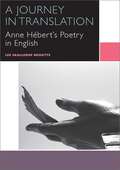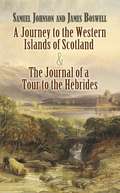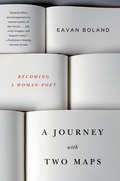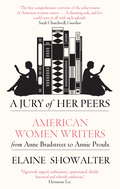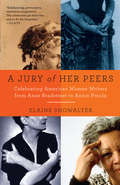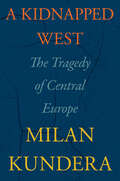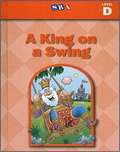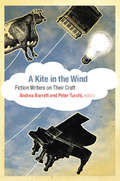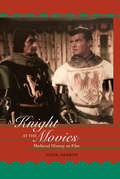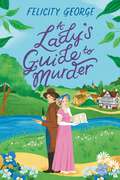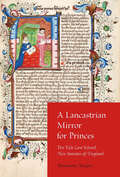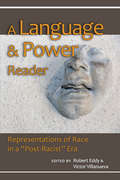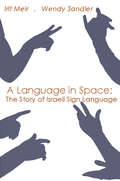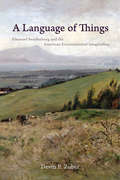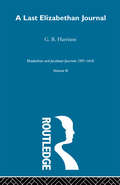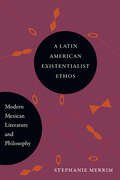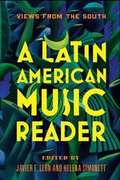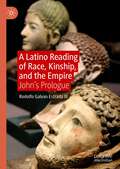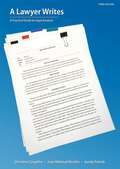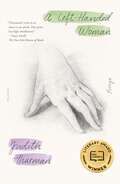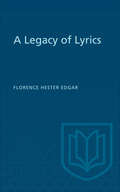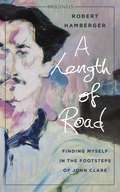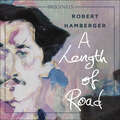- Table View
- List View
A Journey in Translation: Anne Hébert's Poetry in English (Canadian Literature Collection)
by Lee Skallerup BessetteThis book traces the remarkable journey of Hébert’s shifting authorial identity as versions of her work traveled through complex and contested linguistic and national terrain from the late 1950s until today. At the center of this exploration of Hébert’s work are the people who were inspired by her poetry to translate and more widely disseminate her poems to a wider audience. Exactly how did this one woman’s work travel so much farther than the vast majority of Québécois authors? Though the haunting quality of her art partly explains her wide appeal, her work would have never traveled so far without the effort of scores of passionately committed translators, editors, and archivists. Though the work of such “middle men” is seldom recognized, much less scrutinized as a factor in shaping the meaning and reach of an artist, in Herbert’s case, the process of translating Hébert’s poetry has left in its wake a number of archival and other paratextual resources that chronicle the individual acts of translation and their reception. Though the impact of translation, editions, and archival work has been largely ignored in studies of Canadian literary history, the treasure trove of such paratextual records in Hébert’s case allows us to better understand the reach of her work. More importantly, it provides insight into and raises critical questions about the textually mediated process of nation-building and literary canon formation. Published in English.
A Journey to the Western Islands of Scotland, and the Journal of a Tour to the Hebrides
by James Boswell Samuel JohnsonPoet and essayist Samuel Johnson spent the autumn of 1773 touring the coast of Scotland with his future biographer, James Boswell. Each author produced an account of their sojourn, providing not only excellent travelogues and splendid historical records but also fascinating insights into a celebrated literary friendship.
A Journey with Two Maps: Becoming a Woman Poet
by Eavan Boland"Boland offers encouragement to women poets of the future. . . . Her vivid imagery will beguile many."--Publishers Weekly, starred review These inspiring essays from the celebrated poet Eavan Boland are both critical and deeply personal, revealing the adventure, passion, and struggle of becoming a woman poet. In this thematic sequel to her classic Object Lessons, Boland traces her own experiences as a woman, wife, and mother and their effect on her poetry, and she looks to a world where she can change the poetic past as well as the present.
A Joyful Moment
by Katie Shepard Heaven Shivers Charlie Gomez Ethan Van EasterenGetting good news about a beloved old dog . . . Attending a brother's graduation from the Marines . . . . Summer days on a cousin's farm . . . Helping a friend accomplish a goal. Read about these kids' times of joy. Then learn how to write about one of your own joyful moments.
A Jury Of Her Peers: American Women Writers from Anne Bradstreet to Annie Proulx
by Elaine ShowalterFascinating, incisive, intelligent and never afraid of being controversial, Elaine Showalter introduces us to more than 250 writers. Here are the famous and expected names, including Harriet Beecher Stowe, Willa Cather, Dorothy Parker, Flannery O'Connor, Gwendolyn Brooks, Grace Paley, Toni Morrison, and Jodi Picoult. And also many successful and acclaimed yet little-known writers, from the early American bestselling novelist Catherine Sedgwick to the Pulitzer Prize-winning playwright Susan Glaspell.A JURY OF HER PEERS is an irresistible invitation to discover great authors never before encountered and to return to familiar books with a deeper appreciation. It is a monumental work that enriches our understanding of American literary history and culture.
A Jury of Her Peers: American Women Writers from Anne Bradstreet to Annie Proulx
by Elaine ShowalterFascinating, incisive, intelligent and never afraid of being controversial, Elaine Showalter introduces us to more than 250 writers. Here are the famous and expected names, including Harriet Beecher Stowe, Willa Cather, Dorothy Parker, Flannery O'Connor, Gwendolyn Brooks, Grace Paley, Toni Morrison, and Jodi Picoult. And also many successful and acclaimed yet little-known writers, from the early American bestselling novelist Catherine Sedgwick to the Pulitzer Prize-winning playwright Susan Glaspell. A JURY OF HER PEERS is an irresistible invitation to discover great authors never before encountered and to return to familiar books with a deeper appreciation. It is a monumental work that enriches our understanding of American literary history and culture.
A Kidnapped West: The Tragedy of Central Europe
by Milan KunderaA short collection of brilliant early essays that offers a fascinating context for the Milan Kundera’s subsequent career and holds a mirror to much recent European history. It is also remarkably prescient with regard to Russia’s current aggression in Ukraine and its threat to the rest of Europe.Milan Kundera’s early nonfiction work feels especially resonant in our own time. In these pieces, Kundera pleads the case of the “small nations” of Europe who, by culture, are Western with deep roots in Europe, despite Russia imposing its own Communist political regimes in Hungary, Czechoslovakia, Poland, Ukraine, and elsewhere. Kundera warns that the real tragedy here is not Russia but Europe, whose own identity and culture are directly challenged and threatened in a way that could lead to their destruction. He is sounding the alarm, which chimes loud and clear in our own twenty-first century.The 1983 essay translated by Edmund White (“The Tragedy of Central Europe”), and the 1967 lecture delivered to the Czech Writers’ Union in the middle of the Prague Spring by the young Milan Kundera (“Literature and the Small Nations”), translated for the first time by Linda Asher, are both written in a voice that is at once personal, vehement, and anguished. Here, Kundera appears already as one of our great European writers and truly our contemporary. Each piece is prefaced by a short presentation by French historian Pierre Nora and Czech-born French political scientist Jacques Rupnik.
A King on a Swing (Basic Reading Series #Level D)
by McGraw HillHelp children master the phonetic code quickly using the Basic Reading Series. The orderly, logical structure enables even struggling readers to learn virtually all the basis sound/symbol and phonic patterns of English by the time they finish Grade 2.
A Kite in the Wind
by Andrea Barrett Peter TurchiA Kite in the Wind is an anthology of essays by 20 veteran writers and master teachers. While the contributors offer specific, practical advice on such fundamental aspects of craft as characterization, character names, the first person point of view, and unreliable narrators, they also give extended, thoughtful consideration to more sophisticated topics, including "imminence," or the power of a sense of beginning; creating and maintaining tension; "lushness"; and the deliberate manipulation of information to create particular effects.The essays in A Kite in the Wind begin as personal investigations - attempts to understand why a decision in a particular story or novel seemed unsuccessful; to define a quality or problem that seemed either unrecognized or unsatisfactorily defined; to understand what, despite years of experience as a fiction writer, resisted comprehension; and to pursue haunting, even unanswerable questions.Unlike a how-to book, the anthology is less an instruction manual than it is an intimate visit with twenty very different writers as they explore topics that excite, intrigue, and even puzzle them. Each discussion uses specific examples and illustrations, including both canonical stories and novels and writing less frequently discussed, from the 19th, 20th, and 21st centuries, by both American and international authors.The contributors share their hard-earned insights for beginning and advanced writers with humility, wit, and compassion. The first section of the book focuses on narration, with particular attention paid to various kinds of narrators; the second, on strategic creation and presentation of character; the third, on some of the roles of the visual, beginning with establishing setting; and the fourth, on structural and organizational issues, from movement through time to the manipulation of information to create mystery and suspense.
A Knight at the Movies: Medieval History on Film
by John AberthImagining the Middle Ages is an unprecedented examination of the historical content of films depicting the medieval period from the 11th to the 15th centuries. Historians increasingly feel the need to weigh in on popular depictions of the past, since so much of the public's knowledge of history comes from popular mediums. Aberth dissects how each film interpreted the period, offering estimations of the historical accuracy of the works and demonstrating how they project their own contemporary era's obsessions and fears onto the past.
A Lady's Guide to Murder: The new heartwarming and action-packed enemies-to-lovers romantic mystery for 2025!
by Felicity GeorgeIn this spicy historical mystery a duchess finds herself forced to work with her sworn rival to unmask a killer, clear her name and try not to fall in love.'Gorgeous, captivating regency romance' Sophie Irwin'The pen of Felicity George does NOT disappoint' 5* Reader Review'Evocative romance' Virginia HeathTwo sworn enemies. One inconvenient truceWhen the beloved Duke of Severn is murdered, rumours are that Henrietta - his young and scandalous wife - was behind it. Especially once she goes on the run!But Henrietta is not alone.Theo Hawke, her sworn enemy and ruthless journalist, is on her trail determined to be the first to get the scoop.With no other choice Henrietta presents a truce: if he helps her unmask the true identity of the killer then he can publish whatever he likes.Except when their inconvenient truce begins to cause inconvenient feelings, it's not just Henrietta's reputation at stake but her heart too . . .Praise for Felicity George!'Perfect balance of emotion, suspense and love' 5* Reader Review'Sexy, emotional and deliciously romantic' Cressida McLaughlin'A must for regency novels fans' 5* Reader Review
A Lady's Guide to Murder: The new heartwarming and action-packed enemies-to-lovers romantic mystery for 2025!
by Felicity GeorgeIn this spicy historical mystery a duchess finds herself forced to work with her sworn rival to unmask a killer, clear her name and try not to fall in love.'Gorgeous, captivating regency romance' Sophie Irwin'The pen of Felicity George does NOT disappoint' 5* Reader Review'Evocative romance' Virginia HeathTwo sworn enemies. One inconvenient truceWhen the beloved Duke of Severn is murdered, rumours are that Henrietta - his young and scandalous wife - was behind it. Especially once she goes on the run!But Henrietta is not alone.Theo Hawke, her sworn enemy and ruthless journalist, is on her trail determined to be the first to get the scoop.With no other choice Henrietta presents a truce: if he helps her unmask the true identity of the killer then he can publish whatever he likes.Except when their inconvenient truce begins to cause inconvenient feelings, it's not just Henrietta's reputation at stake but her heart too . . .Praise for Felicity George!'Perfect balance of emotion, suspense and love' 5* Reader Review'Sexy, emotional and deliciously romantic' Cressida McLaughlin'A must for regency novels fans' 5* Reader Review
A Lancastrian Mirror for Princes: The Yale Law School New Statutes of England
by Rosemarie McGerrThis seminal study addresses one of the most beautifully decorated 15th-century copies of the New Statutes of England, uncovering how the manuscript's unique interweaving of legal, religious, and literary discourses frames the reader's perception of the work. Taking internal and external evidence into account, Rosemarie McGerr suggests that the manuscript was made for Prince Edward of Lancaster, transforming a legal reference work into a book of instruction in kingship, as well as a means of celebrating the Lancastrians' rightful claim to the English throne during the Wars of the Roses. A Lancastrian Mirror for Princes also explores the role played by the manuscript as a commentary on royal justice and grace for its later owners and offers modern readers a fascinating example of the long-lasting influence of medieval manuscripts on subsequent readers.
A Language and Power Reader: Representations of Race in a "Post-Racist" Era
by Robert Eddy and Victor VillanuevaA Language and Power Reader organizes reading and writing activities for undergraduate students, guiding them in the exploration of racism and cross-racial rhetorics. Introducing texts written from and about versions of English often disrespected by mainstream Americans, A Language and Power Reader highlights English dialects and discourses to provoke discussions of racialized relations in contemporary America. Thirty selected readings in a range of genres and from writers who work in ?alternative? voices (e.g., Pidgin, African American Language, discourse of international and transnational English speakers) focus on disparate power relations based on varieties of racism in America and how those relations might be displayed, imposed, or resisted across multiple rhetorics. The book also directs student participation and discourse. Each reading is followed by comments and guides to help focus conversation. Research has long shown that increasing a student?s metalinguistic awareness improves a student?s writing. No other reader available at this time explores the idea of multiple rhetorics or encourages their use, making A Language and Power Reader a welcome addition to writing classrooms.
A Language in Space: The Story of Israeli Sign Language
by Irit Meir Wendy SandlerThis English version of A Language in Space: The Story of Israeli Sign Language, which received the Bahat Award for most outstanding book for a general audience in its Hebrew edition, is an introduction to sign language using Israeli Sign Language (ISL) as a model. Authors Irit Meir and Wendy Sandler offer a glimpse into a number of fascinatin
A Language of Things: Emanuel Swedenborg and the American Environmental Imagination (Studies in Religion and Culture)
by Devin P. ZuberLong overlooked, the natural philosophy and theosophy of the Scandinavian scientist-turned-mystic Emanuel Swedenborg (1688–1772) made a surprising impact in America. Thomas Jefferson, while president, was so impressed with the message of a Baltimore Swedenborgian minister that he invited him to address both houses of Congress. But Swedenborgian thought also made its contribution to nineteenth-century American literature, particularly within the aesthetics of American Transcendentalism. Although various scholars have addressed how American Romanticism was affected by different currents of Continental thought and religious ideology, surprisingly no book has yet described the specific ways that American Romantics made persistent recourse to Swedenborg for their respective projects to re-enchant nature. In A Language of Things, Devin Zuber offers a critical attempt to restore the fundamental role that religious experience could play in shaping nineteenth-century American approaches to natural space. By tracing the ways that Ralph Waldo Emerson, John Muir, and Sarah Orne Jewett, among others, variously responded to Swedenborg, Zuber illuminates the complex dynamic that came to unfold between the religious, the literary, and the ecological. A Language of Things situates this dynamic within some of the recent "new materialisms" of environmental thought, showing how these earlier authors anticipate present concerns with the other-than-human in the Anthropocene.
A Last Elizabethan Journal V3: Being A Record Of Those Things Most Talked Of During The Years 1591-1610 (Routledge Library Editions Ser.)
by G.B. HarrisonFirst Published in 1999. Routledge is an imprint of Taylor & Francis, an informa company.
A Latin American Existentialist Ethos: Modern Mexican Literature and Philosophy (SUNY series in Latin American and Iberian Thought and Culture)
by Stephanie MerrimWith their emphasis on freedom and engagement, European existentialisms offered Latin Americans transformative frameworks for thinking and writing about their own locales. In taking up these frameworks, Latin Americans endowed them with a distinctive ethos, a turn towards questions of identity and ethics. Stephanie Merrim situates major literary and philosophical works—by the existentialist Grupo Hiperión, Rosario Castellanos, Octavio Paz, José Revueltas, Juan Rulfo, and Rodolfo Usigli—within this dynamic context. Collectively, their writings manifest an existentialist ethos attuned to the matters most alive and pressing in their specific situations—matters linked to gender, Indigeneity, the Mexican Revolution, and post-Revolution politics. That each of these writers orchestrates a unique center of gravity renders Mexican existentialist literature an always shifting, always passionate adventure. A Latin American Existentialist Ethos takes readers on this adventure, conveying the passions of its subjects lucidly and vibrantly. It is at once a detailed portrait of twentieth-century Mexican existentialism and an expansive look at Latin American literary existentialism in relation—and opposition—to its European counterparts.
A Latin American Music Reader: Views from the South
by Helena Simonett Javier F LeonJavier F. León and Helena Simonett curate a collection of essential writings from the last twenty-five years of Latin American music studies. Chosen as representative, outstanding, and influential in the field, each article appears in English translation. A detailed new introduction by León and Simonett both surveys and contextualizes the history of Latin American ethnomusicology, opening the door for readers energized by the musical forms brought and nurtured by immigrants from throughout Latin America. Contributors: Marina Alonso Bolaños, José Jorge de Carvalho, Maria Ignêz Cruz Mello, Gonzalo Camacho DÃaz, Claudio F. DÃaz, Rodrigo Cantos Savelli Gomes, Juan Pablo González, Javier F. León, Rubén López Cano, Angela Lühning, Jorge MartÃnez Ulloa, Julio MendÃvil, Carlos Miñana Blasco, Raúl R. Romero, Iñigo Sánchez Fuarros, Carlos Sandroni, Carolina SantamarÃa Delgado, Helena Simonett, Rodrigo Torres Alvarado, and Alejandro Vera.
A Latino Reading of Race, Kinship, and the Empire: John’s Prologue
by Rodolfo Galvan Estrada IIIThis book provides a Latino reading of John’s prologue with special attention to how the themes of race, kinship, and the empire are part of the gospel’s racial rhetoric. By drawing from the insights of Latinx texts and theology, this book reveals how the prologue provides a lens to read the entire gospel with a keen awareness of Jesus’s engagement with people groups—from his own family to the Roman authorities. The prologue participates in the gospel’s racial rhetoric by shaping the reader’s racial imagination even before a person enters the narrative. By doing so, Jesus’s identity becomes constructed and defined through racial rhetoric since the opening verses of John’s gospel.
A Lawyer Writes: A Practical Guide to Legal Analysis
by Christine Coughlin Joan Rocklin Sandy PatrickThis new edition of the popular text teaches the foundational principles of critical reading, analysis, and writing in a clear and accessible way. By putting the reader in the place of a first-year attorney, the text shows law students how to succeed in law school and in the practice of law.
A Left-Handed Woman: Essays
by Judith ThurmanWINNER OF THE 2023 PEN/DIAMONSTEIN-SPIELVOGEL AWARD FOR THE ART OF THE ESSAYA collection of essays from Judith Thurman, the National Book Award–winning biographer and New Yorker staff writer.Judith Thurman, a prolific staff writer at The New Yorker for more than two decades, has gathered a selection of her essays and profiles in A Left-Handed Woman. They consider our culture in all its guises: literature, history, politics, gender, fashion, and art, though their paramount subject is the human condition. Thurman is one of the preeminent essayists of our time—“a master of vivisection,” as Kathryn Harrison wrote in The New York Times. “When she’s done with a subject, it’s still living, mystery intact.”
A Legacy of Lyrics
by Florence Hester EdgarAfter Florence Hester Edgar passed away in 1944, there was found among her effects a quantity of compositions in prose and verse almost ready for publication. From this literary bequest has been selected the poetry that follows. Some poems were published in the daily press of Ottawa, and others in a small brochure. But most of the poems are now offered to the reading public for the first time, and the editor bespeaks for them a cordial reception.
A Length of Road: Finding Myself in the Footsteps of John Clare: A John Murray Original
by Robert HambergerIn 1841 the 'peasant poet' John Clare escaped from an asylum in Epping Forest, where he had been kept for four years, and walked over eighty miles home to Northamptonshire. Suffering from poor mental health, Clare was attempting to return to his idealized first love, Mary, unaware that she had died three years earlier.In 1995, with his life in crisis and his own mental health fragile, Robert decides to retrace Clare's route along the Great North Road over a punishing four-day walk. As he walks he reflects on the changing landscape and on the evolving shape of his own family, on fatherhood and masculinity, and on the meaning of home.Part memoir, part travel-writing, part literary criticism, A Length of Road is a deeply profound and poetic exploration of class, gender, grief and sexuality through the author's own experiences and through the autobiographical writing of poet John Clare.
A Length of Road: Finding Myself in the Footsteps of John Clare: A John Murray Original
by Robert HambergerA memoir about love and loss, fatherhood and masculinity, class and belonging.In 1841 the 'peasant poet' John Clare escapes from an asylum in Epping Forest, where he had been kept for four years, and walks over eighty miles home to Northamptonshire. Suffering from poor mental health, Clare was attempting to return to his idealized first love, Mary, unaware that she had died three years earlier.In 1995, with his life in crisis and his own mental health fragile, Robert decides to retrace Clare's route along the Great North Road over a punishing four-day walk. As he walks he reflects on the changing landscape and on the evolving shape of his own family, on fatherhood and masculinity, and on the meaning of home.Part memoir, part travel-writing, part literary criticism, A Length of Road is a deeply profound and poetic exploration of class, gender, grief and sexuality through the author's own experiences and through the autobiographical writing of poet John Clare.(P) 2021 Hodder & Stoughton Ltd
